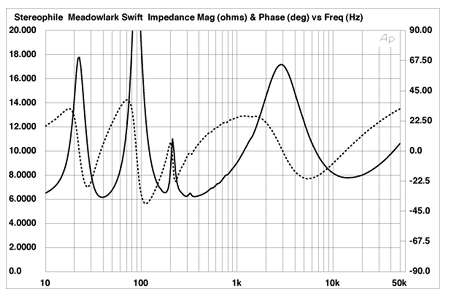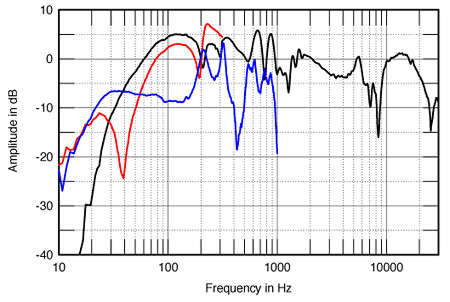| Columns Retired Columns & Blogs |
Meadowlark Swift loudspeaker Measurements
Sidebar 2: Measurements
The Meadowlark Swift is of only average sensitivity: an estimated 86.5dB(B)/2.83V/m. Its impedance (fig.1) doesn't drop below 6.5 ohms, however, rendering it a fairly easy load for the partnering amplifier. While Meadowlark describes the Swift's bass tuning as being a transmission line, the saddle in the impedance magnitude curve in the bass is characteristic of a reflex design. It indicates that the vent is tuned to 39Hz, which implies moderate bass extension.

Fig.1 Meadowlark Swift, electrical impedance (solid) and phase (dashed). (2 ohms/vertical div.)
The sharp peaks at 210Hz and 320Hz in fig.1's magnitude traces suggest that the cabinet has severe resonances of some kind. Checking out the sidewalls' vibrational behavior with an accelerometer revealed nothing amiss; though the acrylic rear panel had some modes present (fig.2), these were not at the frequencies of the peaks in fig.1, suggesting that there are acoustic resonances associated with the Swift's internal air space.

Fig.2 Meadowlark Swift, cumulative spectral-decay plot calculated from the output of an accelerometer fastened to the center of the cabinet's back panel. (MLS driving voltage to speaker, 7.55V; measurement bandwidth, 2kHz.)
This conjecture was confirmed by looking at the responses of the woofer and port in the nearfield. The blue trace in fig.3 is the port output. Note that it peaks at the woofer's minimum-motion point at 39Hz, as with a normal reflex design. But there is a series of peaks higher in frequency, the first two coinciding with the impedance peaks. The Swift's internal line acts as a resonant pipe, with the modes canceling or reinforcing the woofer's output (red trace). Summing the nearfield woofer and port responses gives the black trace in fig.3; while the overall balance is even, it is broken by peaks and dips that, I would have thought, would have contributed to audible colorations in the midrange.

Fig.3 Meadowlark Swift, anechoic response on tweeter axis at 50", averaged across 30 degrees horizontal window and corrected for microphone response, with nearfield responses of the woofer (red) and port (blue) and their complex sum, taking into account acoustic phase and distance from the nominal farfield point (black), plotted below 300Hz, 1kHz, and 400Hz, respectively.
Fig.3 also indicates that the Swift's treble region is slightly shelved-down compared with the midrange—AD did comment on the speaker's slightly soft top end, though John Marks was more impressed by its lack of sibilance when he wrote about it in his November 2002 "The Fifth Element" column. There are major suckouts between 1kHz and 2kHz and between 6kHz and 10kHz, which might well tend to make the speaker sound too polite. However, as the Swift's lateral dispersion plot reveals (fig.4), both suckouts fill in to the speaker's sides, which will even out the perceived treble balance in all but large rooms. But against this must be put the pronounced off-axis step at 1kHz in this graph and the narrowed radiation pattern between 1kHz and 4kHz. In the vertical plane (not shown), the Swift's use of a first-order crossover network results in major changes in balance as the listener moves above or below the tweeter axis, which is a lowish 33" from the floor. Don't sit too high with this speaker.

Fig.4 Meadowlark Swift, lateral response family at 50", normalized to response on tweeter axis, from back to front: differences in response 90 degrees-5 degrees off-axis, reference response, differences in response 5 degrees-90 degrees off-axis.
In the time domain, the Swift's step response on the tweeter axis (fig.5) is beautifully time-coherent, which I assume correlates with the excellent stereo imaging noted by both AD and JM. However, note the strong low-frequency reflection between 7ms and 8ms in this graph. When I measured it, there was nothing close enough to the speaker to produce such a reflection; I suspect it is the reflection of the woofer's backwave from the vent at the end of the line, associated with the resonant behavior in the lower midrange noted above. In my opinion, using transmission-line loading in small speakers like the Swift just doesn't work. The vent at the end of the line still behaves as a reflex port, but the pipe resonances color the sound to an extent that wouldn't occur with a straightforward reflex design.

Fig.5 Meadowlark Swift, step response on tweeter axis at 50" (5ms time window, 30kHz bandwidth).
Finally, while the Swift's farfield cumulative spectral-decay plot (fig.6) doesn't have sufficient resolving power in the frequency domain to uncover the lower-frequency resonances, it does reveal a couple of strong modes in the mid-treble, presumably due to the woofer cone breaking up. I suspect that these modes contribute to AD's not finding the Swift to have the same sense of ease that he found in the other speakers.—John Atkinson

Fig.6 Meadowlark Swift, cumulative spectral-decay plot at 50" (0.15ms risetime).
- Log in or register to post comments




































